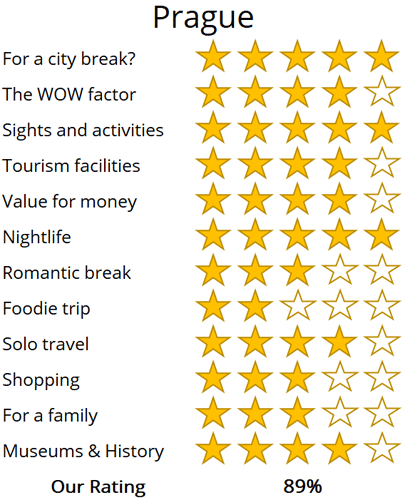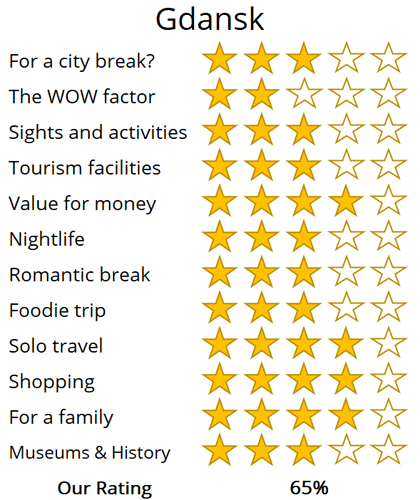WhereToGoForMyHoliday.com
The best destination comparison site!
WhereToGoForMyHoliday.com
The best destination comparison site!
Prague or Gdansk, which is better for your holiday in 2024?
Prague and Gdansk both offer unique and enticing experiences, but which one should you choose for your city break or holiday?
We recognise the difficulty in making this decision. While there is abundant information available on both destinations, clear guidance on which city better aligns with your travel preferences is often hard to find.
This article aims to provide an impartial comparison of Gdansk and Prague, and hopefully help you to choose the best city to visit.
The article is structured into several sections, each of which can be directly accessed through the following links:
• Introduction to the cities
• Scores and ratings
• Which one should I, friends, or family visit?
• When to visit and weather
• Who is the city suited for?
• The perfect 48hours (with map)
• Tourism details (where to stay? airport details?)
Introduction to Prague and Gdansk
Prague, the Czech capital wows visitors with its Gothic castles, cobbled lanes and handsome medieval plazas.It sits on a snaking bend in the Vltava River, unfolding with a fairy-tale Old Town district that flits from curious astronomical clocks to age-old synagogues at just the turn of a corner.
Around that are other neighborhoods that beat with hipster cafes or come topped with the stunning spires of Prague Castle – one of the largest medieval fortifications in the world.
You can fill days glugging frothy beers in cosy basement bars. You can trace the footsteps of Franz Kafka in award-winning literature museums. You can delve into enchanting Christmas Markets or gaze at great monuments on Wenceslas Square.
What's more, Prague sits smack bang in the heart of the beautiful region of Bohemia, a land of undulating hills and beer breweries that offers a taste of rural Europe.
Salt-washed, industrial-chic and filled with hipsters, Gdansk is one of the most happening cities in Poland. It sits on the edge of the Baltic Sea, proudly showcasing its merchant guilds and mansions, a leftover from the years when this was one of the richest ports in the Hanseatic League.
Like most Polish cities, the focal point is an immersive Old Town (also called the Main City) that beats with life and cafés and boutique shops. Around that's a newer city where the remnants of Communist rule still pop up in the tenement blocks and the famous dockyards where the Solidarity movement heralded the beginning of the end for the USSR in the 1980s.
On top of all the architecture and culture is a vibey bar scene that's powered by a hefty student population. There are clubs and pubs everywhere, from the open-air boats on the quaysides to the hidden basement bars in the old quarter. What's more, Gdansk is the gateway to the Polish coast, with Hel Peninsular and its oat-topped dunes close by, or the resort town of Sopot only a short train ride away.
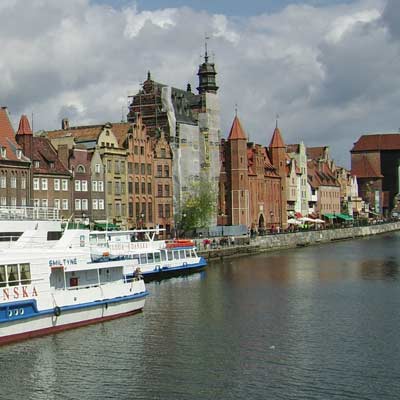
The scenic Długa waterfront in Gdansk

The main square in Prague with the Tyn Cathedral
High-level summary for Prague and Gdansk
Summary
Where would I journey for a personal escape?
Prague
Where would I send my parents for a memorable visit?
Prague
Where's the ideal destination for my adventurous 19-year-old cousin?
Prague
Where should my food-obsessed friend indulge their culinary passions?
Prague
Note: The above comparisons are weather-independent and are based on travel during the most opportune times of the year. Details about the ideal travel seasons are elaborated upon later in this article.
In the sections that follow, you'll find a comprehensive comparison between these two fascinating cities. This includes recommendations on the duration of stay, the best times to visit, and tailored 48-hour itineraries for each city.
The final segment delves into practicalities for your travels, such as the best airport to fly into, the optimal districts for your accommodation, and insider tips, for when you come to explore the city.
We hope that you find all of this information useful, in planning your next exciting trip!
Destination details
How long to spend each city?
Gdansk can be done in just a couple of days, but don't expect that to be enough to do everything. You'll likely want to linger longer, if only to beachcomb the Baltic coast, explore the other corners of the Tri-City (Gdansk is just one of three individual towns that are joined together), and sample as many of the cool hipster bars as you can.
Still, city breaks are very much doable here. Just 48 or 72 hours is ample for checking off the historic sights in the centre, the fascinating dockyards monuments, and to get a feel for the unique fusion of Slavic-Germanic architecture that abounds. Expect to do a lot of walking, though, and be ready to hop on inner-city trains and trams to get from A to B.
During the summertime, you could opt to do as thousands of Polish locals do and extend your Gdansk holiday to a week or two. That'll let you head out to the coast and the beaches. They can be surprisingly stunning, especially along the breezy Hel headland.
Prague is one of the original European city break destinations. With countless low-cost carriers whizzing in and out, it should be easy to put together a short trip here on a budget. To unearth the secrets of the Old Town, see Prague Castle, and enjoy at least a night on the beer and the goulash, a few days is probably all you'll need.
Of course, if you've got extra days, Prague will surely fill them. Excursions out to the wooded valleys of Bohemia, where the castles of Český Krumlov and Kutna Hora await, can be added into the mix. But you could also stay in the city itself, to break away from the more touristy centre into neighborhoods like hipster Žižkov and Nusle.
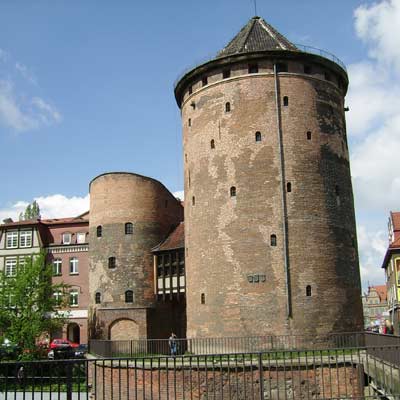
The Stągwie Mleczne was the ancient gateway to the southern side of Gdansk

The delightful Prague Orloj is the world’s oldest operating astronomical clock, and displays the position of the Sun and Moon
Prague has the usual four seasons of Central Europe. The summer is generally hot and humid, with the highest temperatures in the 30s during July and August. It's also common to have regular thunderstorms that last for short bursts then. Winter, meanwhile, is cold. It's the best time to visit Prague if you're in search of kitschy Christmas markets that sell blood sausages, hot chocolate and warm Czech beer. You'll certainly need the thermals and snow coat between November and March, though. It's not uncommon for temperatures to stay below zero for weeks on end.
The upshot is that the spring and autumn probably see Prague in its prime. In April, May, September and October, things can still be mild and warm. There are fewer visitors hitting the mainstay sites like the Prague Castle. Hotel rates drop considerably to boot, and you're more likely to get bargains on flights into town.
Gdansk is surely at its best in the warmer months. Between May and September is when most travellers come. They get to enjoy all the al fresco bars along the old port. They can wander the Old Town without worrying (too much, at least) about rain. They can hit the open-air terraces to taste pierogi dumplings. The weather is a little milder than inland Poland thanks to the tempering effect of the Baltic Sea. Average highs in July are in the low 20s, but that's enough to bring crowds to the beaches of Sopot and the north coast.
The winter in Gdansk can be brutal. The Baltic magnetises icy storms and cold winds across the shoreline and the city. It's a time to get cosy in cute cafes and sip warm beers (yes, that's a thing here), but be certain to pack the thermal leggings and snow coats.
Gdansk has got loads going for it on the travel front. Melding enthralling medieval history with sobering tales of wartime and the proud trade union movement, it's a gem for those looking to unravel the history of Central-Eastern Europe. Shoppers get to delve into Amber shops galore – the city is hailed as one of the best places in the world to buy the glowing fossil. Hedonists get everything from basement bars to wild clubs in old bunkers that stay open all night. Sightseers need only look to the historic Old Town and its grand churches and squares.
Adding to all that, Gdansk has beaches. A quick train to Sopot will reveal one of the nicest in the region, with a long pier that juts out into the Baltic. A little further and you can get to Puck, which sits at the base of what is arguably Poland's finest length of coastline.
Prague is a heritage-rich, historic and hedonistic European city. You'll spend your time gawping at haunting castles and getting lost in medieval districts. Of course, there's also plenty of room for evenings of Czech beer and samplings of Slavic dumplings and goulash. If you're a food-loving culture vulture then there's hardly anywhere better on offer. What's more, backpackers and partygoers will find loads to like in the sleepless basement bars and pubs.
What Prague can't excel in is proximity to the ocean. If you're looking for somewhere to dine on seafood and hit the beach, it's not the place for you. The same goes for the great outdoors. It isn't hard to escape to backcountry Bohemia from here, but you will need to rent a car or organise a day trip away from the Old Town to do that.

The Charles Bridge spans the Vltava River in central Prague and is lined the thirty Baroque statues
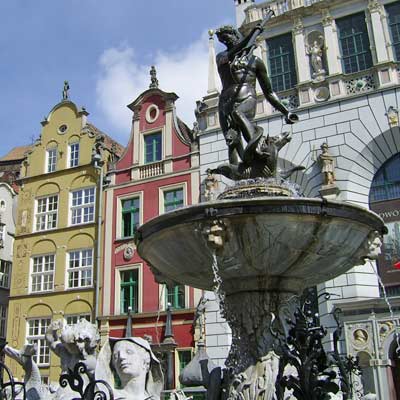
Neptune's Fountain in the historic centre of Gdansk
48hours in Gdansk
Gdansk has big-name sights like the iconic dockyards and its Old Town. But it also has secrets up its millennia-old sleeve. This 48-hour itinerary covers both, with a little bit of partying and beachside living thrown in for good measure…
The interactive map below shows a suggested route for the 48 hours in Gdansk, with day 1 highlighted in green and day two in yellow.
Day 1: Make for Cafe Libertas for breakfast. It's a popular spot with fruit bowls and artisan coffee that will fuel you up right in the heart of the Old Town. Stepping outside the door, you'll find quaint Chlebnicka street, which you can stroll between grand townhouses with Flemish-inspired façades.
At one end is Chlebnicka Gate, still flaunting its original medieval crest from 1450. Beyond is the riverside and the iconic Żuraw Crane. Now a branch of the National Maritime Museum, it's a great detour to make if you want to learn all about the history of shipbuilding in Gdansk.
Delve back into the maze of streets to the west and try to find the St. Mary's Church. It shouldn't be difficult – it's among the three largest brick-built churches on the planet! Past that is bustling Długa. The main drag of the city, it's awash with amber shops, bars, eateries and more.
Stop to sample some pierogi dumplings or grab a beer, and then move on to lovely Long Market square. That's where the famous statue of Neptune beckons, hemmed in by pastel-painted guilds. As evening arrives, return to Długa or Piwna street for basement bars that gush with vodka and cheap beer.
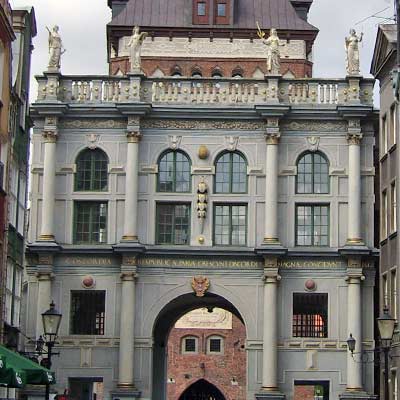
The Złota Brama (Golden Gate) is lined with figures depicting the qualities of the ideal citizen
Day 2: Morning of Day 2 takes you out to the legendary Gdansk Shipyards. If you haven't heard of these already, then buckle in for a history lesson in the fall of Communism. It was here, in 1980, that the powerful Solidarity movement first took route under the leadership of Lech Wałęsa. It would go on to fuel revolutions across the Eastern Bloc, which finished with the fall of the Berlin Wall and the end of Russian dominion in Europe.
There's nowhere better to uncover all that than at the European Solidarity Centre. A visit is likely to take a few hours, especially if you want to drop by the striking Monument to the Fallen Shipyard Workers of 1970 next door. For the afternoon, it's time to explore the Tri-City.
That means hopping on the SKM railway line from Gdańsk Główny. The ride to Sopot is only 15 minutes. It takes you to a lively resort area that's positively brimming with bars and eateries. It's also on the beach, so you might want to spend the evening here, moving between the music venues to famous Sopot Pier.

The European Solidarity Centre commemorates the Polish civil resistance and trade union which began in the Polish shipyards and ultimately led to the collapse of the communism in the USSR

Sopot has a beautiful beach and is an enjoyable destination during the summer season
48hours in Prague
Spending two days in Prague allows for a perfect balance between exploring its historical wonders and delving into its vibrant urban life. The enchanting Old Town and the imposing Prague Castle splendidly represent the city's rich history, while trendy districts such as Žižkov offer opportunities to enjoy coffee and scour through the markets.
Day 1: Start your weekend right in the heart of the city at the expansive Old Town Square, the central hub of Prague's historic quarter. It remains lively throughout the year, bustling with visitors meandering between significant landmarks such as the Old Town Hall and the Church of Our Lady before Týn. Notably, the church is renowned for its striking black Gothic turrets, towering over 80 metres tall.
Meanwhile, the Old Town Hall boasts stunning Gothic doors and gargoyles, and is home to the unique Prague Astronomical Clock. This 15th-century timepiece is the oldest functioning astronomical clock worldwide, drawing crowds every hour to witness its charming chime and the procession of apostles.
Continue east through the Old Town's intricate alleyways until you reach the riverside, leading directly to the iconic Charles Bridge. Adorned with statues of saints, it offers picturesque scenes, especially in the misty winter mornings. Cross over to Malá Strana, Prague’s oldest district, filled with traditional beer taverns such as the popular U Hrocha.
After a refreshing beer, it's time to ascend to Prague Castle, conveniently located steps away from the tavern. Dedicate your afternoon to exploring this vast complex, ranging from the magnificent St. Vitus Cathedral to the quaint workshops of Golden Lane.

The Dancing House may be one of Prague’s most distinctive buildings, but being in the heart of the old town its unique design was extremely controversial
Day 2: Treat yourself to a hearty breakfast in boho Žižkavárna Café. It's loved by the locals for its strong coffees and homemade cakes but is also a fantastic intro to the stylish neighborhood of Žižkov itself. The landmark at the heart of that district of the soaring Žižkov Television Tower in Tower Park Praha. Be sure to take in its futuristic architecture from below before going inside. Then, it's straight up to the observation decks to enjoy sweeping views of the city.
You'll also want to drop by the National Memorial on Vítkov Hill. It's an important spot in the annals of Czech history. It was once a hops plantation but now hosts the colossal equestrian statue of Jan Žižka (a revered Czech military general) and the Tomb of the Unknown Soldier, a symbolic monument to resistance to Nazi occupation.
Keep going north across the river to Prague 7 and you'll find stripped-down hipster cafés like Kavárna Liberál. For dinner, try the multi-ethnic stalls of Hala 22 closer to the waterside, where everything from Rajasthani curry houses to Chinese noodles are options. Finally, get your beer drinking hat on, because Gyllene tigern – a legendary microbrewery – beckons with its hoppy unpasteurized tipples back in the Old Town.

The Klaus synagogue and cemetery, in the Jewish quarter of Prague
The Václav Havel Airport Prague is the main entry point to the Czech capital. It's also the largest international airport in the Czech Republic. That means short-haul flight connections arrive there from all over, and you can usually bag some wallet-friendly bargains on carriers like Ryanair and EasyJet
For a European capital, Prague is very walkable and bikeable. The whole Old Town is actually best explored on foot, and the same goes for the castle district. For longer trips, the uber-efficient Prague Metro and tram network combine on the PID ticket to offer easy hops from A to B.
The basic ticket costs 24 CZK ($1) and allows access and transfers for 30 minutes. Buy them via the Prague transport mobile app, in local newsagents, or at the tram stops themselves. Don't forget to validate your ticket at the yellow machines on board.

The Gothic Saint Vitus Cathedral lies within the Prague castle complex
All the usual crimes and scams of a European capital are present in Prague, though the town is generally very safe for visitors. Be vigilant of pick pocketers in busy areas and on public transport especially. Also try to dodge picking up taxis straight off the street – tourists are often prime targets for inflated rates. Prague's currency exchange points are notorious for being rip offs, so get your koruna before touching down.
For proximity to the main sites and bars, there's really nowhere better to bed down than in the Prague Old Town. Hotels will usually cost the most there, however. Something quieter and equally as atmospheric is available in the Malá Strana. But the New Town district and Žižkov are also both good options.
Getting to Gdansk by plane is easy because of the countless short-haul and low-cost carriers that now fly into the local Lech Wałęsa Airport. A mere nine miles outside of the centre, you can get to the terminals on the 210 bus from the main train station. There are often problems with scam taxi fares to and from the airport, so always agree a rough price beforehand (the normal rate is between 60-80 PLN).
Gdansk's Main City is a joy to walk. The streets of Długa and the quays are all connected by loads of hidden alleys and paths. It might pay to have a tourist map at hand because getting lost is almost inevitable if it's your first time in town.
To travel to the beaches, the shipyards, and Sopot, you'll need to make use of the trams and inter-city SKM trains. The former cost 3.2 PLN per ride. Tickets are available from vending machines at most stations. Be sure to validate as you board.
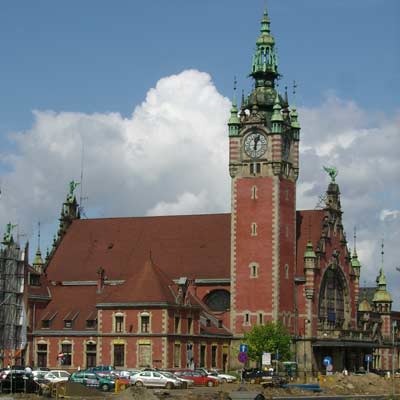
Gdansk Glowny - the main train station of Gdansk
The best location for a hotel in Gdansk is certainly in the Old Town area. There, you'll get boutique lodgings and stylish aparthotels set in centuries-old buildings. An alternative for those who favour beaches and nightlife would be to bed down in Sopot, where resort hotels with swimming pools and stylish restaurants are the norm.
Gdansk is among the most liberal and welcoming of Polish cities. It's got a vibrant LGBT scene and incidents of racism and crime are relatively rare. Still, there are still tensions in Poland and it's wise to be on your guard, especially if out at night in the bars of the Old Town.

oh we were stuck in the airport!

Copenhagen was a bit expensive...

All we did was drink beer in Brussels...

Muncih was crazy

And we got so burnt!

Remeber that night in Rome

oh we were stuck in the airport

So much fun kayaking

Berlin and that group from Austria!

There was such a view from that church

And we got so burnt!

Munich was eventful, wasn't it!

Such a view from that cathedral in Florence

Lisbon was such so much fun

Last summer was so much fun .... x

Remeber that night in Rome

Lisbon was such so much fun

Such a view from that cathedral in Florence

Munich was eventful, wasn't it!

And we got so burnt!

Remeber that night in Rome

All we did was drink beer in Brussels...

Berlin and that group from Austria!

Can't wait to go back to Dubrovnik

Remember that boat ride in Prague

Copenhagen was a bit expensive...
